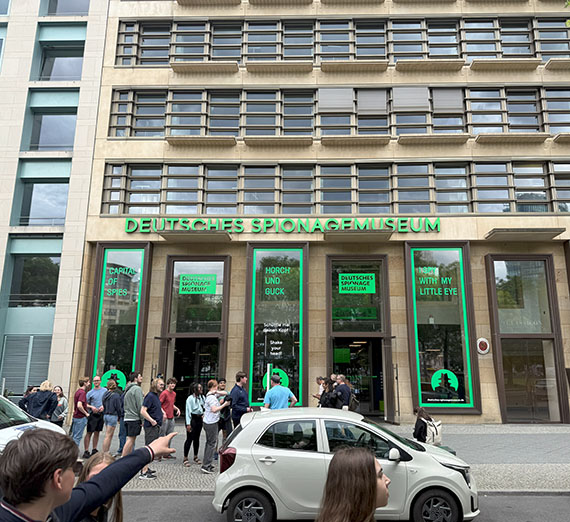GIB: Spies and Spy Tools

Today was a day all about spies and spy tools.
This bright and sunny Tuesday morning started with a lesson on social engineering. Social engineering is defined as the “psychological manipulation of individuals into performing actions of divulging information, often used to bypass traditional security measures.” It's something that occurs in everyday life.
I immediately thought of James Bond and other movie spies. They are constantly using social engineering to get into places they aren’t supposed to. For example, they’ll dress up as janitors to get into secure areas, or say that they need to deliver this package to the boss or they’ll get mad. This is exploiting human trust and urgency to get their desired results, bypassing the security to complete their task.
After lunch, we made our way to the Berlin Spy Museum in Potsdamer Plaza. They set the atmosphere immediately with walls painted with famous quotes from spies and authors such as George Orwell.

A timeline of espionage in the entrance that was really cool. It stated that espionage first dated back to the ancient Mesopotamians, in which a post maker engraved the formula for a glaze on their pot in a encrypted message. It also showed us many spies from throughout history, such as Julius Caesar with his Caesar cypher, Da Vinci with his mirror writing, and Mata Hari, the French double agent from World War II. It was really cool getting to see all these famous historical figures actually had ties to the spy world.


I’ve always found the story of how Britain broke Enigma to be fascinating, both from a computer science perspective and a human perspective. Alan Turing used some of the first ever computers that he invented to crack Enigma, which was not an easy feat to do. We also discussed this in my Calculus III class at Gonzaga, in which we looked at some of the algorithms Turing used to crack Enigma.
The final stage is about spies tools and their job. We look at all sorts of spy tools such as underwater transports, cameras in glasses, and different types of poisons. The lie detector was a favorite, and we asked each other questions. One of the funniest results was when someone asked if Dr. Crandall was my favorite professor at Gonzaga, and I answered no. The lie detector came back and said that was a lie! So Dr. Crandall must be my favorite professor at Gonzaga.

I really enjoyed the spy museum. It showed all sorts of cool info on spies, and showed me a lot that I had never seen before. Overall, today was a great day to learn all about the ways that spies gain access to the info that they need.
